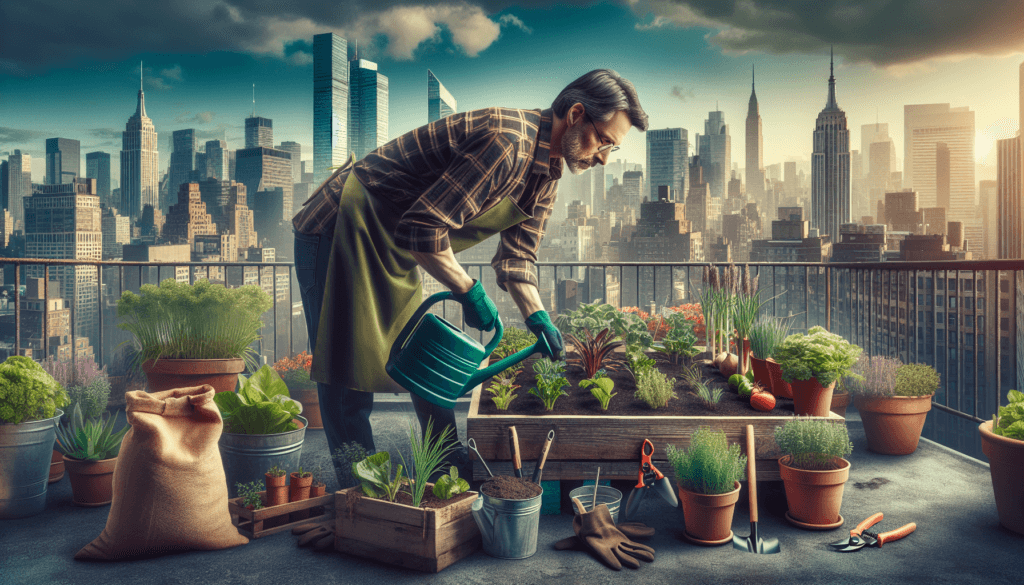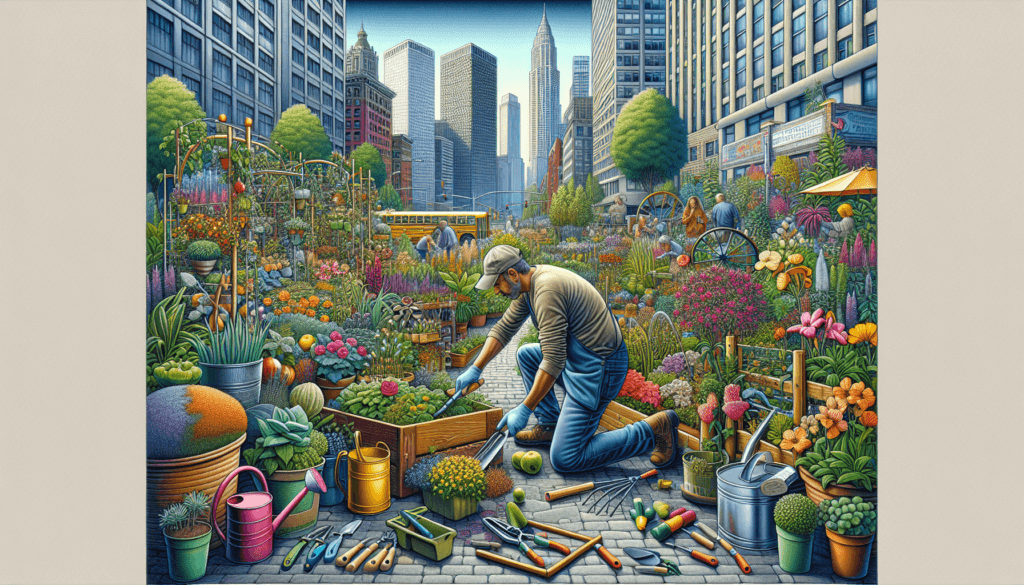Have you ever wondered what an urban gardener does? Well, an urban gardener is someone who specializes in creating vibrant green spaces within city landscapes. From meticulously planning and designing urban gardens to selecting the right plants for specific environments, these skilled individuals work their magic to bring a touch of nature to bustling cityscapes. With their expertise in horticulture, they promote sustainable practices, help combat air pollution, and enhance the overall quality of urban life. So, if you’ve ever found yourself admiring a lush garden amidst a concrete jungle, chances are, an urban gardener had a hand in creating that breathtaking oasis. An urban gardener is responsible for various aspects of planting, cultivating, and maintaining plants in an urban environment. From designing and planning a garden layout to managing pests and diseases, their role encompasses a wide range of tasks. Additionally, they are involved in harvesting and composting, watering and irrigation, maintaining garden infrastructure, educating and engaging the community, researching and experimenting, as well as problem-solving and troubleshooting. Let’s delve into each of these areas in further detail.

Planting and Cultivating
Choosing suitable plants is a crucial first step for any urban gardener. Considering the space constraints and environmental factors, such as sunlight exposure and soil conditions, they carefully select plants that thrive well in urban settings. Preparing the soil is another essential task, involving removing any weeds or debris, tilling or loosening the soil, and incorporating organic matter like compost to improve its fertility. Whether sowing seeds or transplanting seedlings, urban gardeners take care to follow the specific requirements and recommendations for each plant. They ensure that the plants receive adequate watering and fertilization to promote healthy growth. Regular pruning and maintenance activities are also carried out to ensure optimal plant health.
Designing and Planning
Urban gardeners have a keen eye for designing and planning aesthetically pleasing garden layouts. They take into consideration factors such as available space, environmental conditions, and the desired purpose of the garden. By selecting appropriate plant varieties that complement each other in terms of height, color, and texture, they create a harmonious and visually appealing landscape. Considering the climate and environment helps urban gardeners choose plants that can withstand the local weather conditions. They also plan for different seasons, ensuring a diverse and vibrant display of plants year-round. Additionally, they incorporate decorative elements such as sculptures, trellises, or water features to enhance the overall garden design.
Managing Pests and Diseases
An integral part of an urban gardener’s role is identifying and managing pests and diseases that may affect the plants. They are adept at recognizing common pests and diseases, determining the appropriate organic pest control methods, and implementing natural remedies to minimize the impact on plant health. By practicing good garden hygiene, such as removing dead leaves and debris, urban gardeners prevent the accumulation of disease-causing organisms. To further ensure plant health, they diligently monitor the garden for any signs of pest infestations or diseases, and promptly take necessary actions to mitigate their effects.
Harvesting and Harvest Management
Knowing the right time to harvest is crucial to urban gardeners for optimal flavor and nutritional value. They are well-versed in identifying the tell-tale signs of ripeness in fruits, vegetables, and herbs. With careful consideration, they harvest the produce at its peak, maximizing its flavor and nutritional content. Post-harvest handling and storage are also important aspects of an urban gardener’s responsibilities. They ensure that the harvested produce is stored properly to maintain its freshness and quality. Additionally, urban gardeners collect and preserve seeds for future plant propagation. In case of surplus produce, they manage it efficiently by sharing with the community or utilizing preservation methods such as canning or freezing.

Composting and Soil Management
As stewards of the environment, urban gardeners understand the significance of composting and soil management. They create compost systems to transform organic waste into nutrient-rich compost. By collecting organic waste from the garden and kitchen, they create a sustainable cycle of recycling and reducing waste. Urban gardeners maintain compost piles or bins, ensuring the right balance of ingredients like green and brown matter, moisture, and aeration for efficient decomposition. They utilize the resulting compost to improve soil fertility, enriching it with vital nutrients for optimum plant growth. Committed to maintaining healthy soil, urban gardeners regularly test and adjust soil pH and nutrient levels as necessary.
Watering and Irrigation
Understanding plant water requirements is crucial for urban gardeners to prevent under or overwatering. They take into account various factors such as plant type, stage of growth, and prevailing weather conditions to establish efficient irrigation systems. Implementing techniques like drip irrigation or soaker hoses helps conserve water by precisely delivering it to the plants’ root zones. Urban gardeners also adopt water conservation practices, such as mulching the soil to reduce evaporation and preventing water runoff by using rainwater harvesting techniques. By consistently monitoring soil moisture levels, they ensure that the plants receive adequate hydration without compromising water resources.

Maintaining and Upgrading Garden Infrastructure
Urban gardeners are adept at repairing and maintaining garden structures, ensuring their functionality and safety. From maintaining fences, trellises, and raised beds to repairing irrigation systems, they ensure that the garden infrastructure is in good condition. They also consider adding or upgrading garden lighting to enhance the garden’s ambiance and extend its usability during evenings. Creating pathways and providing access within the garden is another aspect that urban gardeners prioritize for efficient navigation and aesthetic appeal. To maximize space utilization, they may build raised beds or containers suitable for small urban gardens.
Educating and Engaging Community
Urban gardeners play an important role in educating and engaging the community in sustainable gardening practices. They organize workshops and training sessions where they teach various gardening techniques and skills. By promoting sustainable practices such as composting, water conservation, and organic pest control, they encourage community members to embrace environmentally friendly approaches. They actively involve the community in garden-related activities, fostering a sense of ownership and pride. Urban gardeners collaborate with local schools or organizations, enabling children and adults alike to connect with nature and appreciate the value of gardening.

Researching and Experimenting
To stay up-to-date with the latest gardening techniques and trends, urban gardeners engage in continuous research and experimentation. They study new methods of planting, cultivating, and maintaining plants, seeking innovative approaches to optimize results. By experimenting with different plant varieties or growing methods, they explore new possibilities and solutions for urban gardening challenges. Urban gardeners also test and evaluate innovative products or tools that can improve efficiency and sustainability in gardening endeavors. Their experiences and knowledge are valuable resources that they readily share with others in the gardening community.
Problem-Solving and Troubleshooting
Urban gardeners possess problem-solving skills that come in handy when faced with gardening issues. They are adept at identifying and diagnosing plant problems, ranging from nutrient deficiencies to pest infestations or diseases. By providing recommendations and solutions tailored to each specific problem, they help rectify issues and restore plant health. Urban gardeners are adaptable and can effectively address changing weather conditions, modifying their gardening practices accordingly. Additionally, they are well-versed in addressing unique challenges faced in urban gardening, such as limited space or poor soil quality, by employing creative problem-solving techniques.
In conclusion, an urban gardener carries out a multitude of tasks to create and maintain thriving gardens in urban environments. From choosing suitable plants and designing garden layouts to managing pests and diseases and harvesting produce, their responsibilities encompass a diverse range of activities. By utilizing sustainable practices, engaging the community, and continuously researching and experimenting, urban gardeners contribute to the growth and development of urban green spaces. Their expertise and passion for gardening make them invaluable contributors to creating vibrant and sustainable urban communities.



